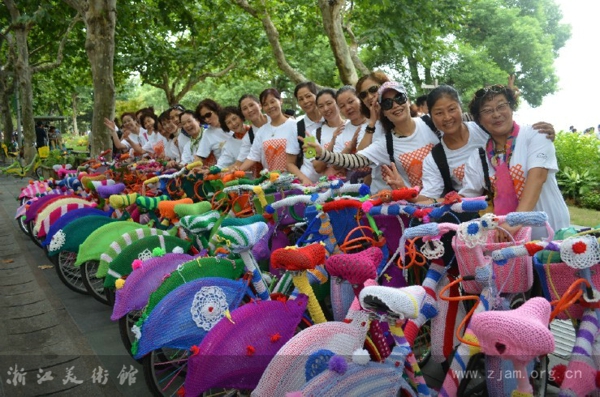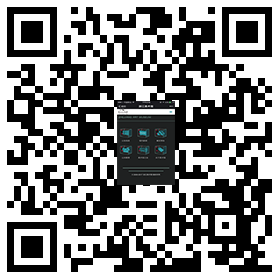The promotion of modern art among the public—the First Hangzhou Triennial Fiber Art Exhibition
pubdate: 2013/10/24 author: 李雯 source: 本站 click:
On September 21st, 2013, the first Hangzhou Triennial Art Exhibition: Fiber--As a Vision had its grand opening alongside the West Lake in the ZJAM after two years’ preparation. During the two-month exhibition, 186 pieces of works of 45 artists from 16 countries were displayed. This has been the very first large-scale modern art exhibition ever since Zhejiang Art Museum was founded. With fiber as its art theme, the exhibition has brought a breath of fresh air to Hangzhou citizens by a large number of soft sculptures, equipments and videos.
In recent years, modern art has become more and more familiar to the public, but it still remains a challenge for art museums to make art aficionados of traditional calligraphy and paintings understand fiber works. Besides lectures and workshops, Zhejiang Art Museum has planned various public education activities since its preparatory stage to expose the modern art to the public.
The exhibition aiming to attract more audience to the museum
At the end of 2011, the exhibition started its preparatory work. In the meantime, its publicity campaign was also orchestrated. On April 26th, 2012, it held a press conference and released its official websites. Two years ago, it also began to regularly place advertisements, posters and articles on Hangzhou local newspapers and art-themed magazines like Contemporary Art, Chinese Sculpture, Contemporary Artists, Art Forum, Flash Art, Frieze, Yishu to catch people’s eyes.
Before the opening ceremony, posters were put on the main streets of Hang Zhou downtown, in the CBD, the subway stations, bus stations, and public bicycle rental spots, and on the LED screens of shopping malls. With the help of China Post, Zhejiang Art Museum gave out 50,000 free tickets at 200 newsstands in Hangzhou and ticket-holders could win a lottery for albums of the exhibition. Obviously, such extensive publicity campaign helped draw much attention. During the 30-day display, the daily visitor volume remained stable at over 3000 on weekends and holidays, and over 2000 in workdays.
Works of art too abstract? Artists in person to introduce its background
Long red tapestries, dreamy feathers and fascinating crystals, garbage bags with embroidery of flowers, gorgeous mid-century costumes, and fiber sculptures —all these modern art works could catch visitors’ eyes at their first sight, but the reasons why they could be art and what ideas the artists want to convey were among questions frequently asked by the audience. Here also lies the crux of the promotion of the modern art exhibitions, that is, works of art can bring strong visual impact yet are difficult for visitors to understand their true meaning.
For that, Zhejiang Art Museum made a 15-minute interview video of the curators and short videos for all the artists to give a comprehensive introduction of their works, artistic background, creation process and display design so as to help visitors better understand the making of every piece of these artistic works. In addition, Zhejiang Art Museum made audio guides for each work so that visitors could rent a free audio guide machine or use their own smart phones to scan the two-dimension codes to download pictures and introductions of the artists, listen to the audio guides, or email them to their own or their friends’ email boxes.
During the exhibition, not only did Zhejiang Art Museum organize three sessions of the curators’ lectures about domestic and overseas costume design, two family workshops: clothing DIY and plant collages, and Suzhou embroidery workshop, but it also worked with the French artist Francois Daireaux to start an interactive workshop. Visitors were invited to recreate his work The Carpet and posted sketches on the Creation Wall of the exhibiting hall. At the end of the exhibition, the most creative sketch would be selected and the winner would take Francois’s work The Socks as an award. These activities aimed to encourage the visitors’ participation and to increase the entertainment of the art museum.
Nearly 300 volunteers participating in the entire process
Besides the curators and working staff, there were nearly 300 volunteers who participated in the exhibition. In May and August of 2013, the local media cooperated with the ZJAM for a public recruitment of volunteers via campus publicity campaigns in dozens of colleges in Hangzhou, including China Academy of Art (the Nanshan campus and Zhuantang campus), Zhejiang Technical Institute of Economics, Zhejiang University of Water Resources and Electric Power, Zhejiang Gongshang University, China Jiliang University, Zhejiang University of Media and Communications, Zhejiang College of Construction, Zhe Jiang Shuren University, Hangzhou Art Vocational School, Hangzhou Normal University, Zhejiang University (Xixi campus, Zi Jingang campus), Zhejiang Economic and Trade Polytechnic, etc. A total number of 1000 volunteers applied on these enrollment sites, and after the interviews nearly 300 were finally recruited. The audience could find a volunteer wall designated by Zhejiang Art Museum in honor of their hard work and enthusiasm. Among the 300 volunteers, there were college students, office workers, and even retired art lovers. They were an indispensible part of the exhibition in that they did not only participate in the whole process of preparation, publicity and display, but also they formed a deep bond with the artists and works of art.
Yarn Bomb bringing modern art exhibition out of the art museum
Whether the exhibitions can be brought out of the museum to make interactions with Hangzhou, the Silk City, has been a big question for the ZJAM during its 3 years’ preparation. As the exhibition period happened to fall in the golden week of the National Day, it became a perfect opportunity for the publicity because visitors at the West Lake would be around one million per day and its butterfly effect would be beyond compare. After active discussions and communications, Zhejiang Art Museum cooperated with Hangzhou public transportation group co., LTD to organize a public bicycle art program for the Hangzhou Triennial Art Exhibition named Yarn Bomb. Twenty colorfully yarn-decorated bicycles weaved by volunteers of the exhibition were sent to 20 public bicycle rental spots during the National Day holiday. On September 28th, Zhejiang Art Museum cooperated with City Express to organize 20 weaving talents to ride their decorated bikes around the West Lake. The news got reprinted by many domestic newspapers and won wide social attention especially after it was released on the museum’s micro blog. For better publicity, Zhejiang Art Museum even made a special two-dimension code for each of the bike. Quite a few visitors who came to Hangzhou for their holiday had a shot of those interesting bikes, and uploaded them to their micro-blogs to share with others. It could be said that this program was a beneficial attempt as a dialogue between the modern art and the city for it not only broke the spatial limit of the traditional displays to let the modern art step out of the museums, but also largely beautified the Hangzhou city with its special publicizing means. Currently, Zhejiang Art Museum is planning for a second session of Yarn Bomb fiber art exhibition by targeting at the trees around the museum and the scenic spots of West Lake.
Fiber Night, first evening show of ZJAM opened to the public
For many exhibits are made of special textures, the best time to appreciate these works of art is evening. On October 15th, teaming up with the local media, Zhejiang Art Museum opened its first Fiber Evening Show of the Hangzhou Triennial Art Exhibition, with its closing hour postponed to 21 o’clock. As this has been the first evening show since the ZJAM was founded, the interactive platform system on Wechat and the hotlines of the museum nearly broke down after the news was released. People were expecting the show so much that the museum got crammed from 17 o’clock in spite of the rainy and cold weather, and the number of the evening visitors surpassed that of the day visitors.
A surprise segment was also prepared by the ZJAM for the evening show. At 19 o’clock, Mr. Xujiang, the Director of the Art Commission of the exhibition and the Dean of China Academy of Art, along with Mr. Ma Fenghui, the Curator of Zhejiang Art Museum, showed up. Their excellent narrations attracted many people to follow them from one hall to another and bursts of applause came out from time to time. Many visitors were so absorbed in the show that they lingered till the closing hour.
A variety of public education and promotion programs enabled the visitors to watch, to entertain, to think and to reflect while visiting the exhibition. With the current background that the government spares no efforts to promote service for the public, this exhibition provided an opportunity for art galleries and museums to learn to offer better service to the public. If ordinary visitors can not understand modern art at the exhibitions, is it really because they lack the artistic culture and taste? If so, what feasible measures could be taken to improve people’s artistic culture and benefit them culturally on the part of art galleries and museums as institutions for public welfare? We hope that we can seize this opportunity to make more inquiries as to how to make the ZJAM a cultural center of modern art to provide the citizens with high-quality cultural services.
Article by Liwen, photo by Zheng Xuechen
 Tel: 0571-87078700 | Site Service:0571-87078700
Tel: 0571-87078700 | Site Service:0571-87078700 Address: NO.138 Nanshan Road Hangzhou Zhejiang
Address: NO.138 Nanshan Road Hangzhou Zhejiang Opening: Tuesday to Sunday 9:00am-5:00pm, Closed Mondays
Opening: Tuesday to Sunday 9:00am-5:00pm, Closed Mondays






